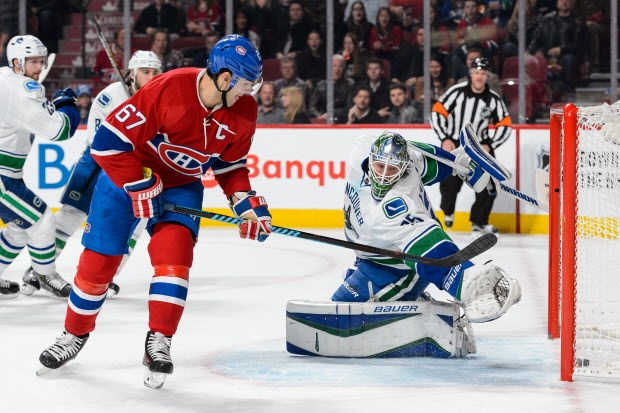You could see it coming from a mile away: the Canucks took a one-goal lead into the third period against one of the best teams in the league. It was inevitable: the Canadiens tied the game late, then won it in overtime.
It’s been a consistent pattern this season: choking away one-goal leads and turning them into one-goal losses. It also, for some odd reason, makes me think of the 2010-11 Canucks.
In my memory, the 2010-11 Canucks were never out of the game. Whenever they were down in the third period, it seemed almost inevitable that they would storm back to tie the game, likely winning in overtime or the shootout.
It’s a memory that’s not entirely accurate. The Canucks did have a league-low 13 regulation losses when trailing after two periods, but that’s mainly because they were so rarely trailing. It just so happened that they trailed going into the third period a league-low 21 times.
The 2010-11 Canucks did manage to win 5 of those 21 games and took 3 of them to overtime, giving them the fourth best winning percentage in that situation, but what was far more important for that team wasn't how they came back from being down but how they held onto leads.
Only the Philadelphia Flyers went into the third period with the lead more times than the Canucks in 2010-11. The Canucks held the lead after two periods 41 times -- exactly half of their games that season. They lost none of them in regulation and only 3 of them in overtime. Their ability to get and keep a lead was instrumental to their dominant season.
Any Canucks season is going to pale in comparison to the 2010-11 Canucks, but this year’s edition actually compares favorably in one area: having a lead going into the third periods.
The 2015-16 Canucks have led going into the third period in more than half of their games: 10 out of 19, tied for the league-lead. They've been able to get leads through two periods at about the same rate as the 2010-11 Canucks. There's just one problem: they’ve already lost more of those games, both in regulation and overtime, than the 2010-11 Canucks did all season.
With a 5-1-4 record when leading after two periods, the Canucks are tied for the worst winning percentage in the NHL in that situation. Their one saving grace is that they’ve at least been able to take most of their losses to overtime. It’s not much of a saving grace because they keep losing those games, but it’s something.
It’s worth noting that the Canucks have also taken the the lead in the third period a few times as well, only to lose the game late. It’s a veritable epidemic.
Comparing the two teams is unfair in many ways. The 2010-11 Canucks had not one, but two elite shutdown centres: Ryan Kesler and Manny Malhotra. The 2015-16 Canucks have, well, none.
Instead, they Canucks have Bo Horvat, whose game hasn’t quite matured just yet, and Brandon Sutter, who is competent defensively, but a far cry from elite. With Sutter injured, the Canucks have had to lean more heavily on Horvat and Henrik Sedin, along with rookie Jared McCann and journeyman Adam Cracknell.
It’s not an ideal situation and it’s exacerbated by a shaky blueline. While Alex Edler and Chris Tanev are a solid top pairing, question marks abound behind them.
Ideally, Yannick Weber would be a third pairing defenceman, combining sheltered minutes at 5-on-5 with a plum power play role. Instead, he’s on the second pairing with Dan Hamhuis, who is no longer the elite two-way defenceman he once was.
On the third pairing, as good as Ben Hutton has been in his rookie year, he’s had some defensive lapses, like on the Canadiens’ tying goal on Monday, while Matt Bartkowski has the speed to consistently transition the puck out of the defensive zone, but doesn’t have the defensive acumen to consistently get the puck to transition it.
This defensive group has been so shaky that there are fans earnestly yearning for the return of Luca Sbisa. I believe that says something about absence, hearts, and fondness.
Add in the overall inexperience of this season’s Canucks, with two teenagers getting regular minutes and youth throughout the lineup, and it’s no surprise that they’ve struggled to hold leads.
The 2010-11 Canucks were all about experience. The only rookie who played more than 16 games for the Canucks that season was Chris Tanev, who came out of the womb a savvy veteran.
That’s not to say that the losses can be pinned on the Canucks’ youth, particularly when some of them are pinned to the bench during those third period collapses. That in itself is an issue: with fewer players that Willie Desjardins feels he can trust to defend a lead, those players can get fatigued, mentally and physically, and make mistakes.
The other possibility is this: the Canucks simply are not that good. Personally, I think the fact the Canucks have taken so many leads into the third period is a sign that they’re better than some people expected. Also, every Canucks loss this season has been by just one goal (yes, every single one, Radim Vrbata totally scored in the final seconds against the Leafs), a sign that the Canucks can hang with every team in the league on any given night.
Still, it’s a distinct possibility that the Canucks are thoroughly mediocre and their inability to close out games is a microcosm of how the entire season will unfold.
I just don’t think that’s the case. While the Canucks are far from the powerhouse team they were in 2010-11, they’re nowhere near as bad as their third periods would suggest.



